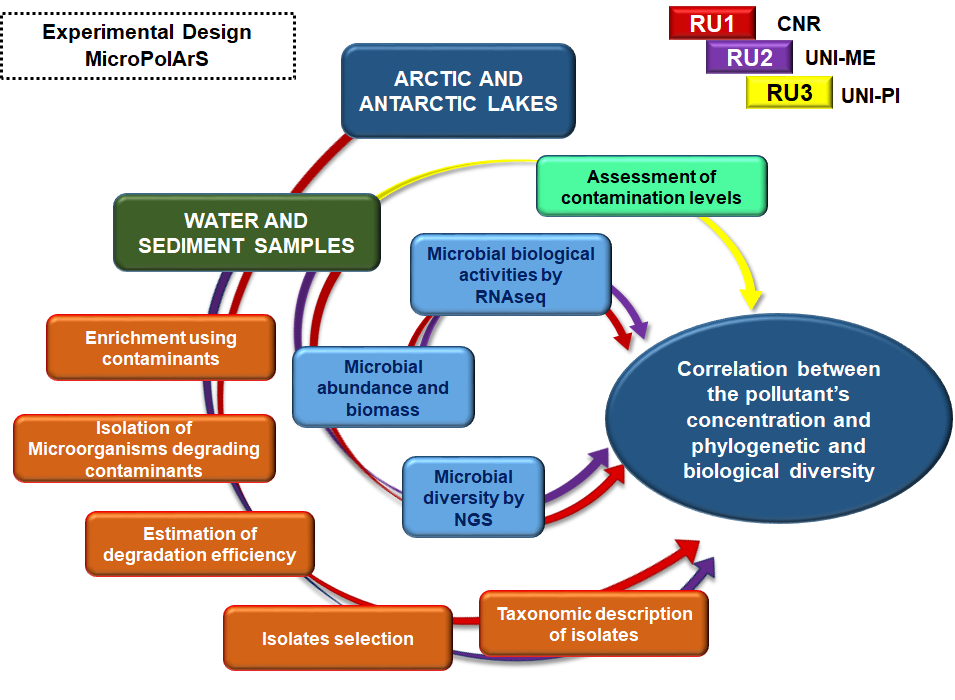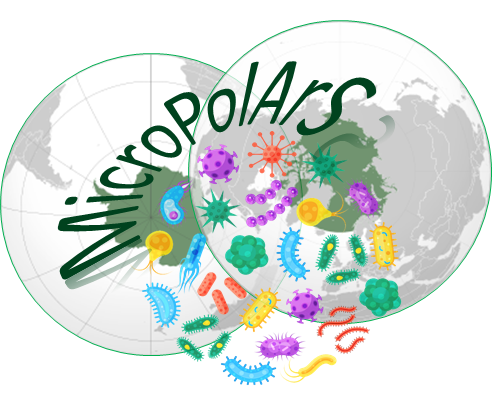- Acronym
- MicroPolArS
- Code
- PNRA18_00194
- Anno
- 2018
- Research area
- Earth science
- Specific research topic
- Characterization and identification of microorganisms with high biotechnological potential
- Region of interest
- Antarctica, Antarctic Peninsula, Deception Island and Arctic, Svalbard Islands, Ny-Alesund
- PI
- Maria Papale
- PI establishment
- Institute of Polar Sciences ISP-CNR
- Institutional website
- http://www.isp.cnr.it
- Other institutions and subjects involved
- University of Messina UNIME, Dip.to ChiBioFarAm, Messina Italy; University of Pisa UNIPI, Department of Chemistry and Analytical Chemistry, Pisa Italy; Cavanilles Institute of Biology and Evolutionary Biology, Valencia Spain
- Consistency of the research team
- Five researchers, one research fellow, two doctoral students and four technicians are currently involved in the project.
- Project status
- In progress
- Main stations used
- Attività svolta in Italia Basi Straniere
- The project
The MicroPolArS (Microbial response to human Pollutants in polAr lakeS) project aims to evaluate the adaptive capacity of microorganisms in extreme and sensitive environments, such as lakes found in polar regions, and to highlight their biotechnological potential applicable for bioremediation. The project will be carried out by the Institute of Polar Sciences of the National Research Council (ISP-CNR) as lead partner, in collaboration with the Cavanilles Institute of Biology and Evolutionary Biology, the University of Messina (UNIME) and the University of Pisa (UNIPI).
Although still in 'common ideology the polar regions are seen as pristine places, in reality multiple studies have shown that this is not true. Many transport mechanisms, both marine and atmospheric, have led over the years to a high accumulation of pollutants that, emitted by industrialized countries, go to deposit on the surface and within the snow and ice covering these areas. The sentinels that can highlight and provide a great deal of information about the damage produced by these pollutants are the lakes themselves. In fact, lakes are extremely sensitive ecosystems, and changes in the dynamics of their snow and ice cover or the deposition of xenobiotic substances can have a significant effect on the ecological variables of the lake. Microorganisms living and developing in the water or sediment of these lakes are excellent at counteracting these perturbations, although this may result in changes in gene expression for them. For example, some microorganisms are able to degrade pollutants such as PCBs (Polychlorinated biphenyls) due to the presence of the Bph operon; others, on the other hand, activate factors such as COG0789, producing proteins that allow them to increase their resistance to xenobiotic substances.
Thus, the MicroPolArS project aims to assess the microbial communities living within polar lakes, with a focus on the diversity and adaptations they have developed in response to the pollutants encountered. The second objective of the project is to isolate and characterize the organisms that have best adapted to the presence of xenobiotic substances and to discover the pathway that allowed them to do so (genetic pathways). Finally, the discovery of the metabolic pathways and/or secondary metabolites capable of eliminating or degrading into simpler substances these pollutants could later be applied to the bioremediation of areas heavily compromised by the presence of pollutants.
- Images
-
- Motivation, importance of research
Lakes are systems that generally exhibit detectable responses to what are environmental perturbations. The sensitivity of lakes to a given stressor depends not only on the intensity of the disturbance, but also on how the lake system processes the environmental disturbance. Some lakes may show an immediate response to a particular disturbance, while others may seem insensitive to the same change. For example, large, deep lakes show greater buffering capacity, expressed by a delayed response, while smaller lakes may show a very rapid and intense response. The small lakes and ponds found widely in Arctic and Antarctic areas are thus highly sensitive ecosystems to environmental changes. Because their size and average thermal state are very close to the freezing point, they may serve as early detectors of change (such as climate change and variation in pollutant concentration). Small changes in the dynamics and duration of their snow and ice covers or the deposition of xenobiotic substances can have a major effect on all detectable ecological variables in lakes.
Many studies have been conducted on the determination of pollutant levels in polar regions. In particular, the distribution of persistent organic pollutants (POPs) and heavy metal contamination within these extreme areas has been studied since the 1970s. The main transport pathways of contaminants to the Arctic and Antarctic include atmospheric and oceanic transport, incorporation into drift ice of pollutants concentrated in the ocean surface microlayer, accumulation on the snow and ice surface of pollutants deposited from the atmosphere, and biological transport by native and or migrating fauna. While pollution in these environments has been extensively studied, information on the responses and supporting metabolic pathways activated by the (micro)biological compartment is scarce. In freshwater ecosystems, microorganisms form the base of the food chain that supports higher trophic levels. Although microbes are generally thought to live in warm regions of the Earth, many of them thrive in cold climates. In addition, microbial communities are more prone to specific changes and responses based on the environmental perturbations to which they are subjected. For example, psychrophilic yeasts show a good ability to efficiently degrade a wide range of phenolic compounds and petroleum hydrocarbons at low temperatures. Recently, cold-adapted yeasts isolated from Antarctica have been shown to have the ability to utilize phenol, methanol and n-hexadecane as a source of C and also to tolerate several heavy metals, such as Cr(VI), Cd(II) and Cu(II). The heavy metal tolerance of cold-adapted phenol-degrading yeasts shows that psychrophilic yeasts could be useful for cold wastewater treatment. Despite concerted efforts over the past 10 years, the literature published to date provides only a fragmentary picture of fungal biodiversity in global glacial habitats, as well as its physiological and biotechnological characteristics. In contrast, it is well known that bacteria possess genetic and biochemical capabilities for the remediation of polychlorinated biphenyl (PCB) pollution. Biodegradation of some PCB congeners, usually less chlorinated, has been reported for several microorganisms in other parts of the world. However, cold-adapted PCB degraders have rarely been isolated from cold environments, such as Arctic soils, water and Antarctic marine sediments. In this context, Dr. Angelina Lo Giudice's group has shown many novel innovations, some of which were reported during the Scientific Committee on Antarctic Research (SCAR 2017-2018). These isolates could provide a viable alternative to the classical methods used for PCB degradation. The prokaryotic and eukaryotic response to human perturbative scanning should be sought in the expression of genetic pathways such as the presence/absence/abundance of the bacterial Bph operon that is involved in the utilization of PCBs as a source of energy and carbon. In addition, the identification of auxiliary genetic information of the plasmid or transcription factors of the MerR family (COG0789), may contribute to the recognition of heavy metal-resistant bacteria.
- Objectives of the proposal
The main scientific objective of MicroPolArS is to obtain new information on microbial activities in polar lakes against pollutants in such sensitive ecosystems. Special attention will be paid to the metabolic pathways underlying these degradation processes. The objective will be pursued by:
1) Evaluation of chemical contamination levels and comparison with results found in previous studies;
2) Analysis and estimation of the biodiversity and activities of prokaryotic and eukaryotic communities, and their distribution in water and sediments;
3) Isolation and characterization of degradative and/or HM-tolerant Prokaryotic and Eukaryotic strains, and estimation of their biodegradation activity at low temperatures;
4) Correlation of all results to obtain an overview of microbial community adaptation and specialization due to environmental pollutant pressure.
Scientific significance of the research
The MicroPolArS Project will enable:
1) Determine the environmental health status, in terms of water and sediment pollution, of selected Arctic and Antarctic lakes;
2) Evaluation of the structure and composition of the microbial community, including assessing the existing correlation with the presence of specific pollutants;
3) In-depth analysis of microbial genetic pathways involved in pollutant degradation and HM tolerance;
4) Isolation of pollutant-degrading bacterial and fungal strains to be applied for bioremediation purposes in polar areas.
It is also expected that the technologies developed will be attractive to companies working in microbial biotechnology. All phylogenetic results will be included in a new database collection that will be accessible to the scientific community to improve knowledge about these extremely and sensitive environments.
- Activities carried out and results achieved
- Products

